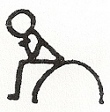THE WAY I REMEMBER IT
During the past few months I have been writing quite a bit about my service in the military during WW II. I guess its because this is the 60th anniversary of the end of the war, and the news has “talked” about the war more than usual. I must say that I was glad that it was over 60 years ago, that we won, and that I was around to witness the event.
Since I have rambled about different parts of “my war,” I thought I would try to write a brief summary of my activities—the way I remember them.
I enlisted in Lubbock , Texas while attending Texas Tech, in January of 1944. I was 17, but was able to enlist because I had my parents consent, and was to be assigned to an Army Specialized Training Program (ASTP) that was being conducted on the campus of Texas Tech. It was an Engineering Outfit.
This came to an abrupt end at the end of the semester in May, and I was assigned to go to Infantry Basic at Camp Fannin near Tyler , Texas . This ended about the end of October, and I was given 10 days to report to Camp Rucker , near Dothan , Alabama . I was assigned to the 66th Infantry Division as a Rifleman.
The 66th was “in the field” doing its final training prior to departing for overseas. I spent about 2 weeks training, then we packed up and headed for Camp Shanks (or maybe it was Camp Kilmer ) near New York City . In about 10 days, we got on the boat for a 10 or 12 day trip to Southampton , England , arriving there around the first of December. We spent the next three weeks in a little village, Lyme Regis, on the southern coast of England . Then we got on the ship for Europe .
It was the morning of Christmas Eve that we shoved off for the “6-9 hour “ ride. At about 6 PM, the ship that we were with, that was carrying the other part of our division, was sunk by a submarine. We lost 1000 men. We sat quietly in the water for three days, and then landed in Cherbourg , France . Our Division History says that we were headed to assist in the Battle of the Bulge, but because of our losses, were instead sent to retain about 50,000 of the enemy that had been cut off in a pocket around the coastal town of St. Nazaire , France. Our job was to hold them so that they could not rejoin the other German forces in their desperate final drive.
I was sent to our front line on December 31 1944. We stayed there until the war ended on May 15, 1944, and were then sent to Koblenz , Germany , supposedly as part of the Army of Occupation. We stayed only two weeks, and were then dispatched back into the “40 and 8” boxcars we had come to know all too well, and sent to Marseille , France . There we helped to “process” troops and their equipment as they were being sent to the Pacific War, or possibly home.
Our stay in Southern France lasted about three months, and in October of 1945 our Division was dissolved, and we became part of the 42nd (Rainbow) Division, and we were sent to Austria . I had several assignments, all around Salzburg .
In the latter part of June, 1946, I headed home through La Havre, France and New York . It was good to see the Statue of Liberty after 18 months. I was discharged in San Antonio and arrived home about July 7, 1946.
Earlier this year I learned that military medals could be obtained by request to a certain place. Since I couldn’t find any of mine except the Combat Infantryman’s Badge, I sent for mine. About six months later a lady called and said that I would receive them soon, and that I would also receive a Bronze Star. I suppose some general figured that if you got shot at and didn’t run you should be so honored.
Vic Mathias – October 20, 2005

